阮一峰 译
本页的封面是英文第一版精装本的封面,文字介绍来自书籍包装。
《通向蜘蛛巢的小路》
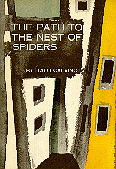
这是一个关于皮恩的故事,他是皮匠的学徒,二战时在海边一个古代利古里亚人的要塞长大,当时德国军队驻扎在镇里,而游击队正从山区打回来。皮恩是个瘦小的孩子, 为了生存下去,他要削尖脑袋去想办法。与其他那些有家的孩子相比,他是个社会的“弃儿”:除了一个当妓女的姐姐,他没有亲人没有家。在“烟雾腾腾,混暗的小酒馆”里,皮恩"被迫在成人的世界里寻找避难所”,那里他听见那些引起了猥亵笑声的谈话,他能模仿那些谈话,但不知道它们的意思。他唱伤感的歌,学会侮辱和诅咒他人--但没有一刻他不在期待成为游击队的一员,“和年轻的伙伴们在一起,他会给他们看蜘蛛建巢的地方,或者和他们在河床上的竹林里战斗。”故事的一部分是他如何加入游击队,并和另一个社会的"弃儿"结为朋友(这是《人鼠之间》之后最奇特的结合之一);但这个故事更主要的是一个男孩的一幅既粗犷又温情脉脉的肖像,这个男孩生活在一个从不需要他参与,也从未打算让他参与的世界里;作者叙述时绝不带有任何多愁善感。事实上, Sean O'Faolain发现作者“对Pavese的性格和Vittorini的硬朗和天真多少有一些主观上的认同。”第一版由Einaudi在1947年出版。1957年由Beacon Press出版英文版,Archibald Colquhoun翻译。
This is the story of Pin, the cobbler's apprentice, who grows up in one of the ancient fortress-towns of the Ligurian coast in the period of World War II when the partisans are fighting back from the hills, and German soldiers are quartered in the town. Pin is a skinny kid who must keep his wits sharp in order to live. With the other boys who have families, he is an outcast: he has no family except a prostitute sister. Pin therefore is "forced to take refuge in the world of grown-ups" in "the smoky violet air of the tavern," where he hears talk which he can imitate—to get obscene laughter—but cannot understand. He sings sentimental songs and learns how to insult and to curse - but all the while he yearns to be one of the gang, "to go off with a band of young companions to whom he could show the place where spiders make their nests, or with whom he could have battles among the bamboos in the river-bed." How he joins the partisans and makes common cause with another "outcast"—one of the strangest combinations since Of Mice and Men—is part of the story; but chiefly this is a tender-tough portrait of a boy living in a world he never made and never would have made; and it is told with absolutely no sentimentalism. In fact, Sean O'Faolain finds that the author "has something of the subjective response to nature of Pavese, and the hardness and innocence of Vittorini." Originally published by Einaudi in 1947. Published by Beacon Press, 1957. Translated by Archibald Colquhoun.
《树上的男爵》
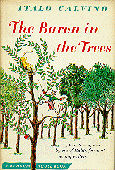
1767 年,柯西莫(Cosimo Piovasco di Rondo)12岁,他是一个具有反叛精神的意大利贵族。一天,他魔鬼似的姐姐贝蒂斯塔做了一些令人毛骨悚然的菜,比如被砍去头的蜗牛,他父亲命令他把这些菜吃下去。为了对抗父亲的专制和不公正,柯西莫象同龄的孩子会做的那样,他爬到了树上。但和别的孩子不一样,从此他拒绝再下来。
《树上的男爵》是一部关于柯西莫独一无二的树栖生活的小说,书中的想象力和智慧令人叹服。柯西莫说,在树上他可以将地面上的事情看得更清楚。从地上那种单调乏味的生活中摆脱出来以后,柯西莫男爵有了和海盗,美女,间谍在一起的传奇经历,还有时间来读书,学习,并且思考一些他那个时代深层次的问题。他和狄德罗和卢梭有书信往来,在军事战略上成了专家,当拿破仑来看他的时候,他令拿破仑也招架不住。
无论何时何地他都在传播真理和正义,他对偷水果的小偷和贵族都同样友好。他将当地一个最让人害怕的大盗变成了孜孜不倦的书迷,大盗对文学的热情导致了最终他本行的荒废。女人们也很愿意来到树枝上和柯西莫在一起。她们中最勇敢的是维奥拉,她出生在意大利以外,金发碧眼,她和柯西莫的感情纠葛是小说中最激烈,最不同凡响的一部分。
这部优美的小说对18世纪的生活和文学进行了充满想象的讽刺。对比伏尔泰讽刺性的虚构作品,卡尔维诺的《树上的男爵》在对崇高和荒谬的把握上展示了非凡的效果。1959年Einaudi出版社第一版。1959年兰登书屋英文第一版, Archibald Colquhoun翻译。
In 1767, when he was twelve years old, a rebellious Italian nobleman, Cosimo Piovasco di Rondo, reacted against his father's authoritarianism and the injustice of being forced to eat macabre dishes—beheaded snails among them—prepared by his diabolical sister Battista. He climbed a tree, as boys that age are wont to do. Unlike other boys, Cosimo never came down.
The Baron in the Trees is the wonderfully witty novel of Cosimo's unique arboreal existence. From the trees, Cosimo explained, he could see the earth more clearly. Free from the humdrum routine of an earthbound existence, the Baron had fantastic adventures with pirates, women and spies, and still had time to read, study, and ponder the deeper issues of the period. He corresponded with Diderot and Rousseau, become a military strategist, and outstared Napoleon when the Emperor paid him a visit.
Dispensing truth and justice from wherever he might be, the Baron was friend to fruit thieves and noblemen alike. he converted the most feared bandit in the area into a dedicated bookworm, whose passion for literature led to his professional downfall. Women were quite willing to go out on a limb for Cosimo. The most daring of all was Viola, the exotic blonde whose love affair with Cosimo is one of the most intense and extraordinary in fiction.
This beautifully written novel is a highly imaginative satire of 18th century life and letters. Reminiscent of Voltaire's satirical romances, The Baron in the Trees displays to dazzling effect Italo Calvino's sure sense of the sublime and the ridiculous. Originally published by Einaudi in 1959. Published by Random House, 1959. Translated by Archibald Colquhoun.
《不存在的骑士》和《分成两半的子爵》
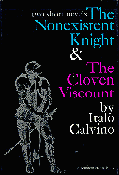
这两个中篇,加上早先的《树上的男爵》,组成了一套充满智慧的寓言似的幻想小说三部曲。它们后来在意大利以“我们的祖先”为标题,重新出版。《不存在的骑士》故意对骑士小说进行了笨拙的模仿。故事中不可能的英雄阿格利鲁尔夫是一套空的盔甲,但又确确实实有英勇的战斗表现,这招来其他骑士的憎恨,以及一个活跃的女骑士布蕾达美特的爱,此外一个对战斗着迷的理想主义者兼志愿者雷姆巴特则对他无比崇拜。阿格利鲁尔夫为了保住骑士的名誉,被迫找遍欧洲以证实他十五年前救过的一个处女的清白。在他的寻找中(对中世纪传奇小说的必有情节的滑稽模仿),他躲开寡妇普蕾斯茜尔拉的勾引,从苏丹的后宫里救出那个不情愿的处女。
《分成两半的子爵》发生在中世纪后期,是一个关于泰拉尔巴的梅达尔多子爵的令人恐怖的故事,子爵在他第一次和土耳其人作战中被一枚炮弹正好炸成两半。他回到奥地利的领地--从字面上说,是半个人--,成为了邪恶的化身,他送给孩子毒蘑菇,将忠心的奶妈赶到麻风村,对一个美丽的牧羊女进行吸血鬼似的求爱。当子爵的另一半奇迹似的出现,并试图消除这些伤害时,宿命中的冲突就不可避免了,小说皆大欢喜的结尾和故事本身一样令人惊奇。作为一个现代人的寓言(被孤立,被伤害),这部小说有深刻的寓意。作为对有关好人与魔鬼的基督教寓言的故意模仿, 这部小说也是机智和清新的。Einaudi出版社1951年和1959年初版,1962年兰登书屋英语第一版,Archibald Colquhoun翻译。
The two novellas, together with Calvino's previously published The Baron in the Trees, make a witty trilogy of allegorical fantasy. Was republished in Italy under the title Our Ancestors. The Nonexistent Knight is an earthy parody of chivalry and knighthood. Agilulf, the improbable hero of this tale, is an empty suit of armor, yet he is the essence of military perfection, resented by his fellow paladins, loved by Bradamante, a dashing female knight, and admired by Raimbaut, an idealistic volunteer who is eager for the glamour of war. In order to retain his knightly rank, Agilulf is forced to scour Europe to verify the chastity of a virgin he rescued fifteen years before. His quest, a burlesque of the time-honored rituals of medieval romance, finds him evading the seductive charms of the widow Priscilla, and rescuing the reluctant virgin from a Sultan's harem.
The Cloven Viscount, set in the late Middle Ages, is the grisly tale of viscount Medardo di Terralba, who in his first battle against the Turks is neatly cut in half by a cannon shot. He returns to his lands in Austria—literally half a man—and becomes the personification of evil, provides children with poison mushrooms, banishes his faithful nurse to a leper colony, and carries on a ghoulish courtship with a beautiful shepherdess. When the other half of the Viscount miraculously appears on the scene and tries to undo the damage, a weird conflict develops, and the happy ending is no less startling than the story itself. As an allegory of modern man—alienated and mutilated—this novel has profound overtones. As a parody of the Christian parables of good and evil, it is both witty and refreshing. Originally published by Einaudi in 1951 and 1959. Published by Random House, 1962. Translated by Archibald Colquhoun.
《宇宙奇趣》
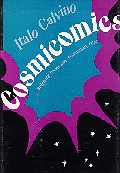
《宇宙连环画》是创造力的高度发挥,它独特的,引人入胜的宗旨是将宇宙进化的理论转变成故事,并从数学公式和单细胞生物中创造角色。 叙述者Qfwfq在没有声音没有时间的真空里度过了他的童年;在宇宙大爆炸的火焰中,他玩弄象弹子一样的氢原子,骑在银河上,满天的追着他的朋友 Pfwfp。后来,作为新诞生的地球上的一个青年,他有了同Ayl, Lll,和Vhd Vhd夫人的羞涩的初恋;当一架梯子出现在他梦里的时候,他顺着它爬到了月亮上;他观察地球上的洪水,以及由此形成的地球大气的第一道色彩;作为一个有冒险精神的年轻脊椎动物,他从海里移民到陆地上;作为一条最后的孤独的恐龙,他漫步在荒芜寂静的高原上,拼命的寻找自己的归属。最让人惊奇的是,Qfwfq 回忆他还是软体动物的情景,那时他还在进化中,没有眼睛,可是他的样子却让所有的眼睛都睁开了。
这些数学和诗化的想象力结合的结果让人无比兴奋。但更深的含义是,无限的时间和空间成为了一个有限生命的瞬间记忆,读者由此一瞥人作为复杂巨大宇宙的一份子的极端渺小。Einaudi出版社1965年第一版,Harcourt, Brace & World出版社1968年英语第一版,William Weaver翻译。
Cosmicomics is a phantasmagoria on Creation, an enchantingly ingenious idea which translates theories about the evolution of the Universe into stories and makes "characters" out of mathematical formulas and simple cellular structures. The narrator, Qfwfq, spends his childhood in the soundless, timeless void; among the incandescent colors of stellar explosions, he plays with hydrogen atoms like marbles and, sitting astride a galaxy, chases his friend Pfwfp around the firmament. Or, as an adolescent on the new Earth, he has his first shy love affairs with Ayl, Lll, and Mrs. Vhd Vhd; climbs up to the moon on a ladder as it looms hypnotically bright over him; watches the planet flood with its first color as an atmosphere forms; migrates as an adventurous young vertebrate from sea to land; or wanders the deserted plateaus as the last, lonely dinosaur, desperately wanting to belong. Most dazzling of all. Qfwfq thinks back on his state as a mollusk evolving, eyeless himself, a shell to delight all eyes.
The result of this entrancing union of mathematics and poetic imagination is pure delight. But more than this: the infinities of time and space contract, becoming momentarily acceptable to the finite mind, and the reader glimpses his own infinitesimal significance as part of the complex vastness of the cosmos. Originally published by Einaudi in 1965. Published by Harcourt, Brace & World in 1968. Translated by William Weaver.
《时间零》

《宇宙连环画》中变来变去的主人公Qfwfq巧妙的穿越时间,空间,太阳系和地质年代,在这些新的故事中又以崭新的面目出现。虽然他还是那样玩世不恭,但是他加深了史前和当今时代之间人类的共同经历是有联系的感觉,也就是对人这个物种在生物学上的更深的认识。他时而是新泽西的上班族, 用身边的现状来歪曲一个地质事件的发生可能性;时而在周末的旅行中考察悬崖,在远古和现代交织的经历中,回忆海水变成血水,以及血水又变回海水。在巴黎 Qfwfq同一个叫普蕾斯茜尔拉的长雀斑的女孩坠入情网,这也许可以被称作一种细胞间的关系。
在这本书的后半部分,Qfwfq从视野里消失了,卡尔维诺将小说进一步推向逻辑和数学的王国。 人,狮子和弓箭一起糊里糊涂的对付时间/空间问题;在交通高峰时间的追杀反而最终在疯狂中找到了一个解决办法;关系复杂的恋人们被高速公路上的疯狂驾驶搞得关系更加复杂,以及诸如此类的故事。
卡尔维诺将科学概念幻想似的运用到现代生活和文学中,用一种轻盈的明晰无暇的散文体,轻松的将人的思维拓展,令人着迷。Einaudi出版社1967年第一版,Harcourt, Brace & World出版社1969年英文第一版,William Weaver翻译,他因本书的翻译获得了国家图书奖。
Qfwfq, the protean hero of Cosmicomics dexterously moving through time and space, solar systems and geological eras, takes on a new dimension in these tales. Though keeping to his playful ways, he heightens the sense of linkage between prehuman and present-day experience, the biological depth, as it were, of our species. We meet him as a commuter from New Jersey, juggling the potentialities of a geological happening with the actualities of the scene around him. We see him go over a cliff on a weekend outing, seas becoming blood and blood the sea, in a mixture of modern and immemorial experience. In Paris, Qfwfq falls in love with a freckled girl named Priscilla, in what may be called an intercellular relationship.
In the latter part of the book, Qfwfq drops from view and Calvino takes fiction one bound further into the realm of logic and mathematics. Man, lion, and arrow deal dizzyingly with the time/space problem; a chase with intent to murder during rush-hour traffic traces the ultimately saving method in the madness; cross lovers are further crossed by the crazy pattern of highway driving - and so it goes.
The mind is stretched and dazzled by Calvino's fantastic application of scientific concepts to modern life and letters, tossed off airily in impeccably lucid prose. Originally published by Einaudi in 1967. Published by Harcourt, Brace & World, 1969. Translated by William Weaver, who received the National Book Award for this translation.
《看不见的城市》
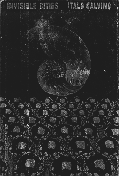
在这部奇特的挑战客观现实的想象性作品中,威尼斯的爱好幻想的旅行家马可波罗和鞑靼国年迈忧郁的统治者忽必烈汗进行了一次对话。马可波罗对可汗回忆了他访问过的城市的景象,那些城市都有着诱人的女性的名字。马可波罗讲述它们的时候,这些城市就如同在中世纪手稿中那样,看上去非常华丽。逐渐的,他的故事中开始包含了现代世界的东西。当旅行家穿越时间和空间,明亮的画面变得不那么赏心悦目了。最后可汗陷入了对那些现在还不存在,但将来会出现的城市的沉思中,这些将来临的噩梦中包括雅胡和勇敢新世界。
“形式的清单是永无穷尽的:只要每种形式还没有找到自己的一座城市,新的城市就会不断的产生。一旦各种形式穷尽了它们的变化,孤立出来,城市的末日就开始了。”这句关键的句子最好的描述了作者安排的这个微妙的游戏,以及他魔术般唤起的过去,现在和将来的各种幻象。戈尔·维达尔写道“要讲清像《看不见的城市》这样一本具有不可思议创造力的书的内容,是所有任务中最困难的,也是完全不必要的。”Einaudi出版社1972 年第一版,Harcourt, Brace, Jovanovich出版社1974年英语第一版,William Weaver翻译。
In this marvelously imaginative work that defies categories, the visionary Venetian traveler Marco Polo and Kublai Khan, the aged and melancholy ruler of the Tartars, engage in a dialogue. Marco Polo conjures up for the emperor the images of cities he has visited—cities with seductive female names. As Marco Polo begins to describe them, they appear jewell-like, as in medieval manuscripts. Gradually, his tales encompass elements of the modern world. The bright pictures become tainted as the voyager moves through time as well as space. in the end the emperor is left brooding over cities that do not yet exist but will come—such future nightmares as Yahoo and Brave New World.
"The catalogue of forms is endless: until every shape has found its city, the cities will continue to be born. When the forms exhaust their variety and come apart, the end of cities begins." This key sentence best describes the subtle game played by the author, the visions of past, present, and future he magically evokes. Gore Vidal wrote that "of all tasks, describing the contents of a book is the most difficult and in the case of a marvelous invention like Invisible Cities, perfectly irrelevant. Originally published by Einaudi in 1972. Published by Harcourt, Brace, Jovanovich, 1974. Translated by William Weaver.
《观察者》
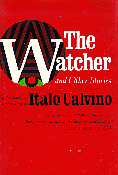
《观察者和其他故事》包含了3篇中篇小说。在小说《观察者》里,写实重于想象。故事发生在都灵里面的科托莱果城,一般人看不见那里,因为那里居住着被人类所遗弃的瘸子,白痴和畸形的人,他们自己组成了一个小天地,教堂负责照顾他们。选举日的时候,一个左翼政党的成员阿梅雷格。奥米欧潜入对手的据点,去看是否存在竞选舞弊。两种人的观念互相碰撞,既令人感动又有揭露性,同时不乏一种巧妙的含糊其辞。
在其他小说里,想象在写实的基础上进一步被发挥。《烟雾》写于1958年,惊人的预言了上升到疯狂高度的对污染的关注。 《阿根廷蚂蚁》是一部有调侃语气的关于难以平息的恐惧的杰作,形象的写出了人类面对一个太微小又无处不在,以至无法征服的敌人时的失败。《观察者》Einaudi出版社1963年第一版;《阿根廷蚂蚁》1952年发表于Botteghe Oscure X,英语版本则收于1957年Collins出版社的《亚当,一个午后》;《烟雾》和< <阿根廷蚂蚁》也被收录于 Einaudi出版社1958年的《I Racconti》;《观察者和其他故事》Harcourt Brace Jovanovich出版社1971年出版,William Weaver翻译。
The Watcher and Other Stories consists of three long stories. In "The Watcher," fact predominates over fantasy. The setting is Cottolengo, a city within the city of Turin, where, hidden from sight, the rejects of the human race - cripples, idiots, monsters - are cared for by the Church in a self-contained world of their own. Here, on Election Day, Amerigo Ormeo, member of a left-wing party, penetrates into the enemy stronghold to see that no election fraud is committed. Two concepts of man confront each other, movingly, revealingly, and not without a subtle ambiguity.
In the other stories fantasy rockets off from its base in fact. "Smog," written in 1958, marvelously anticipates a preoccupation with pollution that is raised to lunatic proportions. "The Argentine Ant" is a masterpiece of sustained horror with farcical undertones, illustrating man's defeat before an enemy too small and ubiquitous to be overcome. "The Watcher" (La giornata d'uno scrutatore) was originally published by Einaudi in 1963; "The Argentine Ant" ("La formica argentina") was originally published in Botteghe Oscure X in 1952 and in English in Adam, One Afternoon in 1957 by Collins; "Smog" ("La nuvola di smog") and "The Argentine Ant" were also published in I Racconti in 1958 by Einaudi; The Watcher and Other Stories was published by Harcourt Brace Jovanovich in 1971. Translated by William Weaver.
《如果冬夜,一个旅人》
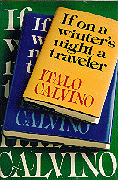
《如果冬夜,一个旅人》其实不是一部小说,而是十部,每一部都有不同的情节,作者,氛围和风格;每一部都在第一章后嘎然而止,留下悬念。两个读者,一男一女,在这个迷宫中追踪着激起他们兴趣的故事线索。这样下去, 《如果冬夜,一个旅人》就和另一本书,来自波兰的有洋葱烧焦气味的《在马尔堡镇外》,不可避免的纠缠在一起了。
当这本书进展下去,又接触到了其他已知和未知的文学作品,其中包括了一种从已灭绝的语言翻译过来的作品,作者从全能鉴赏家的角度调侃的指出了现代文学的变化。那两个晕头转向的读者被紧紧联系在一起,最后他们在一张大床上互相阅读。他们才是这个故事真正的英雄:如果没有能起反应的读者,写作又是为了什么呢? 它会变得毫无意义。Einaudi出版社1979年第一版,Harcourt Brace Jovanovich出版社1981年英语第一版,William Weaver翻译。
If on a winter's night a traveler turns out to be not one novel but ten, each with a different plot, author, ambiance, style; each breaks off with the first chapter, at the moment of suspense. A labyrinth, no less, in which two readers, male and female, pursue the story lines that intrigue them. Thus, If on a winter's night a traveler gets inextricably mixed up with Outside the town of Malbork, a work of unquestionable Polish origin, redolent of somewhat carbonized onions.
As the book branches out into known and unknown literatures, including a translation from an extinct language, the author, not without malice, rings the changes of contemporary literature with virtuoso versatility. The two bewildered readers tie their own knots and end up in a king-size bed for parallel readings. They are the true heroes of the tale: for what would writing be without responsive readers? Would it be at all. Originally published by Einaudi in 1979. Published by Harcourt Brace Jovanovich, 1981. Translated by William Weaver.
《命运交叉的城堡》
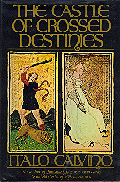
卡尔维诺以他不可思议的机智,用塔罗牌的图案和上面的原型人物创造了一系列短篇的幻想故事。在一个童话般的环境--位于茂密森林的腹地中的一座城堡和一个客栈--一群男人和女人偶然的遇在一起。 他们被这种奇遇搞得心烦意乱,并且发现他们都失声了。为了交流他们的命运--爱情,战斗,征服,背叛--他们必须一个接一个的用玩游戏的塔罗牌的组合来暗示自己命运中几个场景。一些故事是真正的民间神话传说--帕西发尔(亚瑟王传奇中寻找圣杯的英雄人物),俄狄浦斯,哈姆雷特--但其他完全是卡尔维诺自己的创造。所有这些故事都象一个混合着古老和现代的多棱镜;作者精确的揭示了我们狂热,不稳定的二十世纪世界中的潜在的神话元素,用古代的符号对我们现在的样子进行讽刺挖苦。
卡尔维诺从一套十五世纪漂亮的塔罗牌(其中有八张是按照实际的尺寸和颜色进行了复制的)中得到灵感。一套十八世纪塔罗牌的图案被黑白的复制在这些故事的页边,联起来显示故事的进展。 他使用方法正是算命的人使用的方法,但他的方法更复杂;他创造的实际上是一种填字和填图的游戏。这本书在它的创造性上,在对塔罗牌的使用上,在它既优雅又微妙的写法上,都是令人着迷的。Ricci出版社1969年第一版,Einaudi出版社1973年再版,Harcourt Brace Jovanovich出版社1976年, 1977年英语版,William Weaver翻译。
With magical dexterity, Italo Calvino uses the device of tarot cards and their archetypal images to create a series of short fantastic narratives. In a fairytale setting - a castle and a tavern in the heart of a dense wood - a company of men and women are brought together by chance. Distraught by strange adventures, they find they have lost their voices. To communicate their fates—love affairs, battles, conquests, betrayals—they must deal out, one after the other, the cards of a game of tarot, whose configurations reveal their several plights. Some of the stories turn out to be authentic folk myths and legends—Parsifal, Oedipus, Hamlet—but others are entirely Calvino's own. All of them have a prismatic blend of the old and the new; the author has pinpointed the potentially mythic elements in our frenzied, plastic twentieth-century world and uses ancient symbols to comment wryly on what we have become.
Calvino was inspired by a series of beautiful fifteenth-century tarot cards, eight of which are reproduced in actual size and full color. Black-and-white reproductions of an eighteenth-century pack run along the margins of the tales, showing the combinations out of which the stories grew. His use of the cards is precisely that made by fortunetellers, but his method is more complicated; he has created what amounts to a crossword and crossimage diagram. The book is fascinating in its inventiveness, in the evocative use of the tarot, in the elegance of its twists and turns. Originally published by Ricci in 1969. Published by Einaudi in 1973. Published by Harcourt Brace Jovanovich, 1976, 1977. Translated by William Weaver.
《马可瓦多》
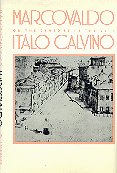
天生的梦想家马可瓦多,智多星马可瓦多。作为20世纪五六十年代意大利北部一个乏味的工业城市的低级工人,马可瓦多善于发现自然美,并热切的渴望更靠近他想象中未受到破坏的世界。他追寻他的梦想,为了减轻身上的负担,他用他的直率,而不是世故的方法,来压制他的幻想和尝试,他的举动另他的妻子,孩子,老板和邻居都大惑不解。他带来的结果永远是任何人都想不到的。
在20 个有着迷人魅力和非凡创意的故事中,伊塔罗。卡尔维诺创造了一幅令人难忘的肖像,叙述了智勇兼备的马可瓦多的经历:他策划在自家屋顶上诱捕鸟雀,他为了找到木柴砍下高速公路上广告牌,他为了照顾一株办公室里的植物(他背运时的伙伴)不惜走极端。无论是对“合成食品”进行一个人的战争,还是带着他的一家在一个他一件东西也买不起的超级市场里的梦幻旅行,马可瓦多都显示了独一无二的本性。Einaudi出版社1963年第一版,Harcourt Brace Jovanovich出版社1983年英语第一版,William Weaver翻译。
Marcovaldo the irrepressible dreamer, Marcovaldo the inveterate schemer. An unskilled worker in a drab northern Italian industrial city of the 1950s and 1960s, Marcovaldo has a practiced eye for spotting natural beauty and an unquenchable longing to come a little closer to the unspoiled world of his imagining. Much to the puzzlement of his wife, his children, his boss, and his neighbors, he chases his dreams, gives rein to his fantasies, tries—with more ingenuousness than skill—to lessen his burden and that of those around him. The results are never the anticipated ones.
In twenty stories of striking charm and exuberant originality, Italo Calvino creates a memorable portrait, recounting Marcovaldo's adventures with grade, verbe, and wit: Marcovaldo plotting to trap game birds on his apartment house roof, Marcovaldo chopping down highway billboards for firewood, Marcovaldo going to extremes to care for an office plant (his companion in misfortune). Whether vowing a personal war against "synthetic foods" or leading his family in a trancelike tour of a supermarket in which absolutely nothing is affordable, Marcovaldo remains inimitable himself. Originally published by Einaudi in 1963. Published by Harcourt Brace Jovanovich in 1983. Translated by William Weaver.
《困难的爱》
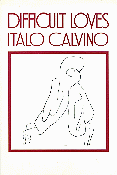
除了卡尔维诺还有谁能如此准确和优美的捕捉普通人生活中的一个个瞬间,并将现实和幻想熔于一炉?一个面包店里的小偷,一个小酒馆里的狂热夜晚,一个陷入性幻想的年轻士兵,一个游泳时发现比基尼泳衣掉了下半截的中产阶级妇女--所有这些都被卡尔维诺的如花妙笔写成了一篇篇杰出探索人类内部复杂世界的小说。在这些二十世纪四五十年代的杰作中,卡尔维诺描写了当对爱的自我欺骗和幻觉(经常是自我恋爱)被揭破时,那些觉悟和警醒的瞬间。Harcourt Brace Jovanovich1983年英语第一版,William Weaver, Archivald Colquhoun, 和Peggy Wright翻译。
Who but Italo Calvino could blend realism and illusion to capture so precisely and so elegantly these moments in the lives of ordinary people? A theft in a pastry shop, a frenzied evening in a tavern, a young soldier caught up in a private fantasy of seduction, a middle-class woman who discovers while swimming that she has lost the lower part of her bikini—all are transformed by Calvino's consummate artistry into stories that brilliantly explore intricate interior worlds. In these classics of the 1940s and 1950s, Calvino depicts instants of recognition and alarm, when cherished deceptions and illusions of love—frequently self-love—are stripped away. Published by Harcourt Brace Jovanovich, 1983. Translated by William Weaver, Archivald Colquhoun, and Peggy Wright.
《文学的作用》
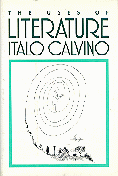
在这些散文中,卡尔维诺对文学进行了反思,他把文学看作一个巨大的叙述游戏,在这个过程中作者和读者被挑战去理解世界。他讨论了文学和科学,哲学和政治的关系。他分析了过去经典作家著作的各个方面--荷马和《奥德赛》,亚理奥斯多(Ariosto)和《奥兰都的疯狂》(Orlando furioso),巴尔扎克和城市。 文集的最后是对当代作家的赞美:欧金尼奥。蒙塔莱,罗兰。巴特,和梅瑞安·穆尔。
从卡尔维诺的文学批评中可以看到很多他编织进自己作品的主题:城市的形象,控制论,神话和民间故事,英雄文学的冒险旅程。在《电影和小说 》中,卡尔维诺甚至透露了一个关于他小说的很有意思的小秘密:“如果说有电影事实上曾经影响过我的一些小说的话,那么它就是卡通片。”
卡尔维诺自己编选了这部文集。它所传递的文学兴趣和批评洞见对于从一个新的角度理解文学的作用,以及对一个现代大师作品的全面理解,是一个重要的贡献。Einaudi出版社1980年, 1982年版,Harcourt Brace Jovanovich出版社1986年英文版,William Weaver翻译。
In these essays Calvino reflects on literature as process, the great narrative game in the course of which writer and reader are challenged to understand the world. He discusses literature in relation to science, philosophy, and politics. He analyzes aspects of the works of the great classical writers of the past—Homer and the Odyssey, Ariosto and Orlando Furioso, Balzac and the city. The collection concludes with tributes to contemporary writers: Eugenio Montale, Roland Barthes, and Marianne Moore.
From Calvino's criticism emerge many of the themes that are woven into his own work: the image of the city, cybernetics, myth and folktale, the heroic journey. In "Cinema and the Novel" Calvino even drops a fascinating aside about his own fiction: "If any part of cinema has in fact influenced some of my work, it is the animated cartoon."
Calvino himself made the selection of pieces to be included in this volume. The literary interests and critical insights expressed are an important contribution to an understanding of the uses of literature and to a comprehension of the work of a modern master. Originally published by Einaudi in 1980, 1982. Published by Harcourt Brace Jovanovich, 1986. Translated by William Weaver.
《意大利民间故事》
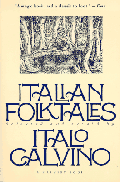
除了卡尔维诺还有谁能挑选出200个意大利民间故事,并如此出色的复述它们?读者被引入了一个极富意大利特色的世界,那里皇帝和农夫,圣徒和魔鬼,以及一系列最奇特的植物和动物,在充满当地风俗和历史的背景上演出了一个个生动的故事。 无论叙述是幽默的还是质朴的,是玩笑的荒谬的还是贵族的神秘的,这些故事都是严格按照想象的逻辑有趣的展开的。
《意大利民间故事》被纽约时报评为当年的十佳新书之一,并立即赢得了童话爱好者们的心,也使卡尔维诺进入了象格林兄弟和安徒生那样伟大的童话作家的行列。在这本书里,卡尔维诺将丰富的想象与非凡的捕捉人之梦境和幻想的写作能力结合在一起。Harcourt Brace出版社1980年英文第一版,George Martin翻译。
Who but Italo Calvino could have selected two hundred of Italy's traditional folktales and retold them so wondrously? The reader is lured into a world of clearly Italian stamp, where kings and peasants, saints and ogres - along with an array of the most extraordinary plants and animals—disport themselves against the rich background of regional customs and history. Whether the tone is humorous and earthy, playful and nonsensical, or noble and mysterious, the drama unfolds strictly according to the joyous logic of the imagination.
Chosen one of the New York Times's ten best books in the year of its original publication, Italian Folktales immediately won a cherished place among lovers of the tale and vaulted Calvino into the ranks of the great folklorists like the Brothers Grimm and Hans Christian Andersen. In this collection Calvino combines a sensibility attuned to the fantastical with a singular writerly ability to capture the visions and dreams of a people. Published by Harcourt Brace, 1980. Translated by George Martin.
《帕洛马先生》
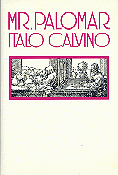
《帕洛马先生》是卡尔维诺最出色的作品之一,《树上的男爵》和《宇宙连环画》后又一部杰作。它的名字和一架著名的望远镜相同并非巧合。帕洛马先生是一个知识的探索者,一个在神圣和荒谬的世界里的梦想家。帕洛马先生利用假期对自然现象进行了考察:海龟交配的冲动,白天的月亮,晚上的天空。回到城里后,他又去了商店,被冻肉卷,黄油,沙锅炖肉所吸引。它们的名字和标签使他联想到了草原,打猎,和畜牧业的各种禁忌。帕洛马先生真正感兴趣是思想。一家熟食店就是一座文明的博物馆。他对社会上的事没有兴趣也不参与,宁愿在内心里交谈,倾听无限空间的寂静和鸟雀动听的鸣叫。但时时来打搅的,文明化的"自我"坚持要成为一个保守的彬彬有礼的绅士,这对一座望远镜来说是失败,对帕洛马先生却又值得高兴。这是一个机智,优雅,充满幻想的故事。Einaudi出版社1983年第一版,Harcourt Brace Jovanovich出版社1985年英文第一版,William Weaver翻译。
Mr. Palomar is one of Calvino's most brilliant creations, a descendant of the Baron who lived in the trees and the enchanting Cosmicomics. It is no accident that his name recalls that of a famous telescope. Mr. Palomar is a quester after knowledge, a visionary in a world sublime and ridiculous. On vacation, Mr. Palomar focuses on natural phenomena: the passion of mating turtles, the moon by day, the sky by night. Returning to the city, he goes off to shop and becomes absorbed by galantines, pâtés, terrines. Names and labels conjure up scenes of pastures, of the hunt, of sacred traditions of husbandry. Mr. Palomar's palate is in his mind. A delicatessen is a museum of civilization. He is impatient and taciturn in society, preferring to spin inner dialogues and listen to the silence of infinite spaces and the song of birds. Yet the intrusive, civilized "I" insists on being that crusty, charming gentleman, a failure as a telescope, a delight as Mr. Palomar. This is a witty, elegant, fantastic tale. Originally published by Einaudi in 1983. Published by Harcourt Brace Jovanovich, 1985. Translated by William Weaver.
《在美洲豹太阳下》
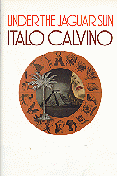
在这些机智,幻想的小说中,感觉--味觉,听觉,嗅觉--主宰了主人公的生活。《在美洲豹太阳下》里一对夫妻为了在一种辣椒和外国香料做的菜肴中,找到性爱和精神恋爱的微妙的结合,去墨西哥旅行。《国王在听》里登基的暴君既是他权利的囚徒,也是他耳朵的囚徒,因为他巨大宫殿里的回声带来各种关于判决,爱情和阴谋的相互矛盾的信息。《名字,鼻子》里一位见多识广的男士苦苦琢磨时髦的香水,为了找出一个戴面具的神秘女郎留下的香味,而在伦敦一个吸毒的摇滚歌手则象一只发情的野兽,一位女士的气味使他展开了疯狂的寻找。
这些感觉看似可以促使欲望得到满足,自我得到发泄,但最终却只满足了它们的来源:品尝的嘴巴,倾听的耳朵,嗅味的鼻子。
三种感觉,三篇意大利大师用艺术语言才华横溢的再现的奇遇。《在美洲豹太阳下》1983年第一次发表在《纽约人》上;《名字,鼻子》1976年第一次发表在《安泰》(Antaeus)上。Garzanti出版社1988年第一版,Harcourt Brace Jovanovich出版社1988年英文第一版。
The senses—taste, hearing, and smell—dominate the lives of the characters in these witty, fantastical stories. In "Under the Jaguar Sun" a couple tours Mexico to discover a startling combination of sublime and erotic love in the cuisine of fire-hot chiles and exotic spices. In "A King Listens" the enthroned tyrant is prisoner not only of his power but also of his ear, as echoes in his huge palace carry contradictory messages of deliverance, love, and betrayal. In "The Name, the Nose" a man of the world consults a fashionable parfumerie in search of a scent worn by a mysterious masked lady, while in London a drugged rock musician ruts like an animal in heat for the female whose odor lures him into crazed pursuit.
And so the senses, promising the fulfillment of desire and an exit from the self, only lead back to their source: the savoring palate, the listening ear, the smelling nose.
Three senses—three brilliant adventures into the art of narration by the Italian master. "Under the Jaguar Sun" was first published as "The Jaguar Sun" in The New Yorker in 1983; "The Name, the Nose" was first published in Antaeus in 1976. Originally published by Garzanti in 1988. Published by Harcourt Brace Jovanovich, 1988.
《未来千年文学备忘录》
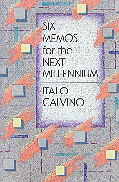
伊塔罗·卡尔维诺在动身前往哈佛大学前夕去世,他本来要在那里主讲1985-1986年度的查尔斯·艾理奥特·诺顿讲座。由于天性沉默,他总是不愿意谈他自己,但他对谈文学的发展很有兴趣。在准备他的演讲过程中--他妻子回忆说这“困扰”了他生命的最后一年--他不可避免的要提及他自己的作品,他的方法,意图和希望。这样,这本书就成为了卡尔维诺留给我们的遗赠:他为未来的人们指出的要重视的那些普遍的文学标准,也成为我们进入卡尔维诺自身世界的暗号。
写作应该重视哪些问题?卡尔维诺用非常简洁的安排,为五种必不可缺的文学标准的每一种都准备了一次演讲(对读者来说就是一个备忘录)。第一个是“轻盈”,卡尔维诺引用了卢克菜修,奥维德,薄迦丘,卡瓦尔康蒂,列奥帕第,和昆德拉--还有其他一些作家,都是用来--表明他的意思:如果要显示生存的重负,那就应该轻盈的显示。另一个必要的文学标准是“迅捷”,一种将行动(用诸神的使神墨丘利象征)和沉思(用克罗诺斯农神象征)联系起来的敏捷。下一个是“准确”, 语言的精确和明晰。第四讲是“可视性”,作为了解世界和自身的一种手段的视觉意象。然后是独具匠心的“繁复”,卡尔维诺出色的描述了一些文学怪人(福楼拜,加达,穆希尔,佩拉克,和他自己),以及他们试图表达人类面对既痛苦又诱人的无限的可能性的努力。 第六讲也是最后一讲--已计划还未完成--叫做“连贯”。也许一开始我们感到意外,但接着我们就会思考卡尔维诺会如何讲这一讲,就象他的其他作品一样,这样的思考总会产生更多的思考。通过这本书,卡尔维诺给了我们在本世纪撰写的最雄辩的,最少防御的“文学辩护词”--它也是给下一个千年的合适的礼物。埃斯特·卡尔维诺指导了这本书的出版预备工作。她是伊塔罗·卡尔维诺的阿根廷出生的妻子,担任过好几个国际组织的翻译。哈佛大学出版社1988年第一版, Patrick Kreagh翻译。
Italo Calvino died on the eve of his departure for Harvard, where he was to deliver the Charles Eliot Norton Lectures in 1985-86. Reticent by nature, he was always reluctant to talk about himself, but he welcomed the opportunity to talk about the making of literature. In the process of devising his lectures—his wife recalls that they were an "obsession" for the last year of his life—he could not avoid mention of his own work, his methods, intentions, and hopes. This book, then, is Calvino's legacy to us: those universal values he pinpoints for future generations to cherish become the watchword for our appreciation of Calvino himself.
What about writing should be cherished? Calvino, in a wonderfully simple scheme, devotes one lecture (a memo for his reader) to each of five indispensable literary values. First there is "lightness" (leggerezza), and Calvino cites Lucretius, Ovid, Boccaccio, Cavalcanti, Leopardi, and Kundera—among others, as always—to show what he means: the gravity of existence has to be borne lightly if it is to be borne at all. There must be "quickness," a deftness in combining action (Mercury) with contemplation (Saturn). Next is "exactitude," precision and clarity of language. the fourth lecture is "visibility," the visual imagination as an instrument for knowing the world and oneself. Then there is a tour de force on "multiplicity," where Calvino brilliantly describes the eccentrics of literature (Flaubert, Gadda, Musil, Perec, himself) and their attempt to convey the painful but exhilarating infinitude of possibilities open to humankind.
The sixth and final lecture—worked out but unwritten—was to be called "Consistency." Perhaps surprised at first, we are left to ponder how Calvino would have made that statement, and, as always with him, the pondering leads to more. With this book Calvino gives us the most eloquent, least defensive "defense of literature" scripted in our century—a fitting gift for the next millennium. Esther Calvino supervised the preparation of the book. She is Italo Calvino's Argentinian-born wife and a translator for several international organizations. Published by Harvard University Press, 1988. Translated by Patrick Kreagh.
《通向圣吉瓦尼之路》
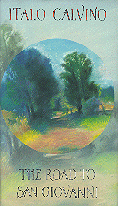
这本二十世纪一位必不可少的作家所做的重要自白,包含了五篇有关他生活和工作的打动人心的优美的“记忆练习”。《通向圣吉瓦尼之路》中卡尔维诺痛苦的回忆了他的童年环境,“站在圣皮尔切山脚的最后一个斜坡上,就好象站在两个大陆的边界上”。 《观众回忆录》给出了一段对卡尔维诺青少年时代迷人的描述,那时他去电影院“几乎每天一次,有时甚至一天两次”,被加里·古柏扮演的孟加拉骑兵的生活和查理斯·兰顿和克拉克·盖博为奖金而发生的叛变所牢牢吸引。《一场战斗的回忆》尖锐的聚焦在第二次世界大战中他和法西斯战斗的经历,但随后又变成了一段对记忆中真实和想象的成份所扮演角色的感人的反思。《La Poubelle Agréée》是巴黎生活的一段插曲,《出于模糊》则表达了作者的信条。
在《通向圣吉瓦尼之路》中,原创性,优雅,机智和智慧这些被我们认为与卡尔维诺联系在一起的东西,随处可见。Mondadori出版社1990年第一版,Pantheon出版社1993年英文第一版,Tim Parks翻译。
This major testament by an essential writer of the twentieth century is comprised of five strikingly elegant "memory exercises" about his life and his work. "The Road to San Giovanni" poignantly evokes Calvino's childhood home, "on the last slopes at the foot of San Pietro hill, as though at the border between two continents." "A Cinema-Goers Autobiography" gives a mesmerizing account of the years of Calvino's adolescence, when he attended the cinema "almost every day and maybe even twice a day," riveted by such films as Lives of a Bengal Lancer with Gary Cooper and Mutiny on the Bounty with Charles Laughton and Clark Gable. "Memories of a Battle" sharply focuses on his experience fighting the Fascists during World War II but becomes in turn a deeply affecting reflection on the role of real and imagined memories. "La Poubelle Agréée" is a Parisian set-piece and "From the Opaque" is essentially his writer's credo.
In The Road to San Giovanni, the originality, grace, wit, and wisdom that we have come to associate with Calvino are everywhere on display. Originally published by Mondadori in 1990. Published by Pantheon, 1993. Translated by Tim Parks.
《黑暗中的数字》
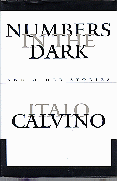
这本优美的选集收录了一些才气横溢的小说,寓言和“不可能的访谈”,它的出版是一个重要的文学事件,进一步巩固了卡尔维诺作为一个二十世纪必不可少的作家的地位。在一幢房子烧焦的废墟里发现一张“可恶契约”的清单,里面还有四具尸体,一个计算机程序员决定去找出谁列了这张恐怖的清单,但他自己也不知不觉陷入了这个致命阴谋。一个旅行者遇到了一架为了达到平等主义而造出来的全新的机器:它用来在任期结束的时候砍去国家官员的头。一个3万5千岁的尼安德特人从杜塞尔多夫城外的美丽的尼安德山谷来到现代社会,一个访问者要求他证实他之所以能活这么久,仅仅是因为他渴望成名。传奇风流高手卡萨诺瓦讲述一个逃跑者的故事:那个将她的每一个部分--精神上的或者其他方面--都贡献出来的女人,是否事实上是在使用一种狡猾的策略来逃避追捕?
这几十篇写于1943年至1984年间的短篇小说中,既有古怪恐怖的故事,又有兴奋愉快的,既有悲剧扭曲的,又有甜蜜残忍的--有时它们交替出现,有时又一起出现。这些小说涉及很多主题--政治,权力的性质,技术无情扩散的影响,对真理的探索,人类沟通的困难--它们全是纯卡尔维诺式的。Mondadori 出版社1993年第一版(Primal che tu dica "Pronto"),Pantheon出版社英文版,Tim Parks翻译。
A major literary event: this enchanting collection of diabolically brilliant stories, fables, and "impossible interviews" confirms Italo Calvino's stature as one of the essential writers of the twentieth century. A list of "abominable deeds" is found among the charred remains of a house and the four bodies in it, and it is up to a computer programmer to discover who composed the macabre inventory—before he himself becomes ensnared in the deadly conspiracy. A tourist encounters a whole new machinery for the attainment of egalitarianism: the beheading of state officials at the end of their respective terms. Coming to you live from the picturesque Neander Valley just outside Düsseldorf: an interviewer asks the 35,000-year-old Neanderthal Man to justify the fact that his mere endurance is his sole claim to fame. And the legendary lover Casanova tells of the one who got away: was the woman who offered up every part of herself, spiritual and otherwise, in fact employing a cunning strategy to evade capture?
Written between 1943 and 1984, these several dozen short fictions are whimsical and horrific, feverish and delightful, tragic and wry, sweet and brutal—sometimes alternately, sometimes all at once. Ranging over a panoply of concerns—politics, the nature of power, the implications of a relentless application of technology, the quest for truth, and the elusive possibility of human connection—they are all of them pure Calvino. Originally published by Mondadori in 1993 (Primal che tu dica "Pronto"). Published by Pantheon. Translated by Tim Parks.
《幻想故事》
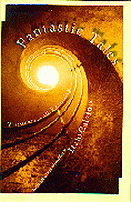
卡尔维诺编辑的《幻想故事》是从许多引人注目的十九世纪欧洲和美洲的作者的作品中,选出的26篇经典的神秘故事组成的一本内容丰富范围广泛的集子。本人就是杰出作家的卡尔维诺为这本集子写了一篇帮助理解的导言,并为每个故事写了吸引人的纲要。
《幻想故事》整理了这种类型作品的发展演变,从它在德国浪漫主义的起源一直到亨利·詹姆士的鬼故事。卡尔维诺写道“幻想故事是十九世纪叙述体作品中最有特色的品种之一。对我们来说,它也是意义最重大的那类作品之一……当用我们今天的眼光去看它们时,这些故事核心中的超自然元素无一不带有含义,就象意识中那些被忽略的,被压抑的,被忘记的东西的反抗……在这里我们看到了它们现代性的一面,这也是它们在我们这个时代胜利般的复苏的原因。”
《幻想故事》是一本规范奇特的文集,由这样一个编辑者编选,用赛尔曼。卢士达的话来说就是“他拥有看透人类意识最深处,并把那里的美梦带回现实生活的能力。”包含在这本独特的文集中的十九世纪作家有安徒生,巴尔扎克, 安布罗斯·格威纳特,狄更斯,吉卜林,莫泊桑,艾伦坡,沃尔特·司各特,以及许多其他作家。Mondadori出版社1983年第一版,为独立的两卷本,原名"Racconti Fantastici Dell'Ottocento: Volume Primo, Il Fantastico Visionario and Volume Secondo, Il Fantastico Quotidiano",兰登书屋1997年英文版。
Compiled by Calvino, Fantastic Tales is a rich and wide-ranging collection of twenty-six classic, uncanny tales from the nineteenth century written by an intriguing panoply of European and American authors. Master storyteller himself, Calvino has contributed an informative introduction to the collection, and an engaging précis to each story.
Fantastic Tales traces the genre from its roots in German Romanticism to the ghost stories of Henry James. Calvino writes: "The fantastic tale is one of the most characteristic products of nineteenth-century narrative. For us, it is also one of the most significant . . . As it relates to our sensibility today, the supernatural element at the heart of these stories always appears freighted with meaning, like the revolt of the unconscious, the repressed, the forgotten . . . In this we see the modern dimension of the fantastic, the reason for its triumphant resurgence in our times."
Fantastic Tales is a fantastically canonical anthology assembled by an editor who, in the words of Salman Rushdie, "possesses the power of seeing into the deepest recesses of human minds and then bringing their dreams back to life." Originally published as two separate volumes, Racconti Fantastici Dell'Ottocento: Volume Primo, Il Fantastico Visionario and Volume Secondo, Il Fantastico Quotidiano, by Mondadori in 1983. Published by Random House, 1997.